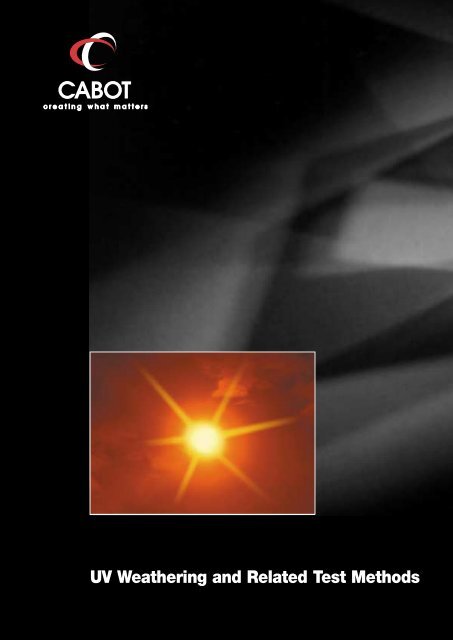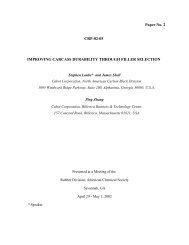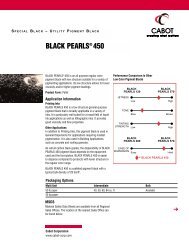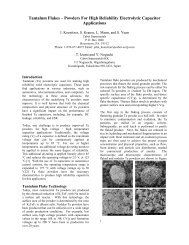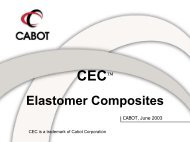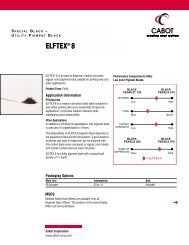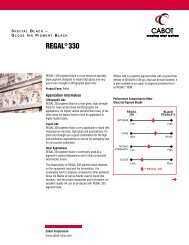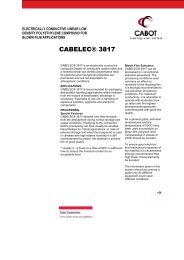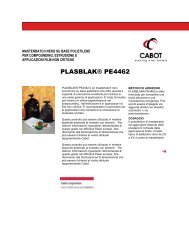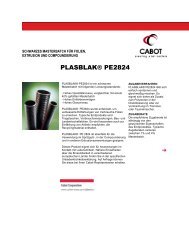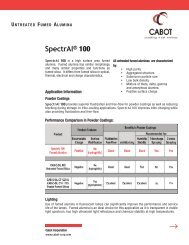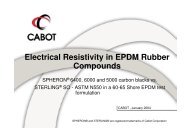UV Weathering and Related Test Methods - Cabot Corporation
UV Weathering and Related Test Methods - Cabot Corporation
UV Weathering and Related Test Methods - Cabot Corporation
You also want an ePaper? Increase the reach of your titles
YUMPU automatically turns print PDFs into web optimized ePapers that Google loves.
<strong>UV</strong> <strong>Weathering</strong> <strong>and</strong> <strong>Related</strong> <strong>Test</strong> <strong>Methods</strong>
2<br />
<strong>UV</strong> <strong>Weathering</strong> <strong>and</strong> <strong>Related</strong> <strong>Test</strong> <strong>Methods</strong><br />
Table of Contents<br />
Page<br />
I. Introduction to <strong>Weathering</strong> 3<br />
1. <strong>UV</strong> light spectrum <strong>and</strong> solar radiation 3<br />
2. Radiation energy – definitions 4<br />
3. Average solar radiation by country 5<br />
4. Light stabilizers for plastic materials 6<br />
a) <strong>UV</strong> light absorbers 6<br />
b) Quenchers 7<br />
c) Hindered Amine Light Stabilizers (HALS) 7<br />
II. <strong>Weathering</strong> <strong>Test</strong> <strong>Methods</strong> 8<br />
1. Natural weathering 8<br />
2. Artificial weathering chambers 9<br />
a) Q<strong>UV</strong> fluorescent light source 9<br />
b) Xenon lamp weathering (Ci65A chamber) 10<br />
c) Q<strong>UV</strong> versus Xenon lamp testing 11
Introduction to <strong>Weathering</strong><br />
Long term exposure to sunlight leads to the degradation of plastic<br />
materials. In particular, the non-visible <strong>UV</strong> radiation characterized by<br />
short wavelengths is responsible for photo-degradation, a process<br />
that generally results in breaking down the polymer chains. This<br />
frequently results in a deterioration of the physical properties,<br />
changes in color or chalking of the part surface. As an example, films<br />
lose their flexibility <strong>and</strong> disintegrate, garden furniture becomes brittle<br />
or stadium seats become chalky.<br />
In order to limit or postpone the onset of degradation, several types<br />
of <strong>UV</strong> light stabilizers can be added to the polymer. The most<br />
important stabilizer types work by screening out the harmful<br />
ultraviolet light - for instance <strong>UV</strong> absorbers such as benzophenones<br />
or small dispersed particles such as carbon black or inorganic<br />
pigments. Other very effective <strong>UV</strong> stabilizers are <strong>UV</strong> quenchers <strong>and</strong><br />
HALS (Hindered Amine Light Stabilizers). A brief description of these<br />
stabilizers is given in the next pages.<br />
One important factor, when the light stability of a given material or the<br />
performance of a <strong>UV</strong> stabilizer needs to be assessed, is the selection<br />
of a suitable test method. Besides outdoor exposure that closely<br />
reflects natural weathering conditions but requires long exposure<br />
times, artificial weathering tests have been developed using light<br />
sources such as Xenon arcs or fluorescent lamps under controlled<br />
temperature <strong>and</strong> humidity conditions.<br />
Ultraviolet light spectrum <strong>and</strong> solar radiation<br />
<strong>UV</strong>B VISIBLE INFRA RED<br />
280 nm 315 nm 385 nm 780 nm 3 µm<br />
SOLAR SPECTRUM<br />
The solar spectrum covers a broad range of radiation including short<br />
wavelength <strong>UV</strong>'s, visible light, as well as infrared radiation.<br />
3
4<br />
Radiation components<br />
<strong>UV</strong> radiation represents only 4.6% of the solar spectrum, but causes<br />
the most important damage to the polymeric materials. The complete<br />
solar <strong>UV</strong> spectrum ranges between 280 <strong>and</strong> 400 nanometers, but the<br />
most aggressive part is the <strong>UV</strong>B range with very short wavelengths<br />
between 280 <strong>and</strong> 315 nanometers.<br />
visible light<br />
45%<br />
<strong>UV</strong><br />
5%<br />
Radiation energy: definitions<br />
The irradiation is the radiation energy incident over a specific area<br />
for a given period of time. It is expressed either in W*s /m 2 , Joule/m 2<br />
or very often in Langley (Ly).<br />
1 Ly = 1 cal/cm2 = 4.184 E 4 Joule/m 2<br />
infrared<br />
50%<br />
Example : what is the total irradiation for a 3-year outdoor exposure<br />
in Belgium?<br />
➢ annual sunlight radiation in Belgium : 80 kLy (see table below)<br />
➢ total irradiation after 3 years : 80 x 3 = 240 kLy<br />
The global annual sunlight radiation level (kLy/year) for various<br />
countries is given in the table below. It corresponds to the radiation<br />
energy that can be transmitted to a plastic part in one year of<br />
continuous outdoor exposure.<br />
Note: values in this table are only indicative. Within certain (larger)<br />
countries, radiation levels can vary significantly from one area<br />
to another.
Average solar radiation per country in kLy (kcal/cm 2 /year)<br />
COUNTRY kLy<br />
Austria 80<br />
Afghanistan 180<br />
Alaska 70<br />
Algeria 160<br />
Angola 120<br />
Argentina 160<br />
Australia 180<br />
Bahamas 140<br />
Bahrain 200<br />
Belgium 80<br />
Burma 120<br />
Bolivia 140<br />
Brazil 120<br />
Bulgaria 100<br />
Canada 100<br />
Chad 200<br />
Chile 140<br />
China 140<br />
Columbia 100<br />
Costa Rica 140<br />
Cuba 140<br />
Cyprus 140<br />
Denmark 70<br />
Egypt 200<br />
Ecuador 120<br />
El Salvador 140<br />
Ethiopia 140<br />
Finl<strong>and</strong> 70<br />
France 120<br />
COUNTRY kLy<br />
Germany 80<br />
Great Britain 70<br />
Greece 120<br />
Guatemala 140<br />
Guyana 120<br />
Haiti 160<br />
Hong Kong 140<br />
Honduras 140<br />
Hungary 80<br />
India 180<br />
Indonesia 140<br />
Iraq 180<br />
Iran 180<br />
Israel 180<br />
Italy 120<br />
Jamaica 160<br />
Japan 100<br />
Jordan 180<br />
Kenya 140<br />
Kuwait 180<br />
Korea 120<br />
Lebanon 180<br />
Luxembourg 80<br />
Libya 180<br />
Madagascar 140<br />
Mali 200<br />
Malta 160<br />
Malaysia 140<br />
COUNTRY kLy<br />
Morocco 160<br />
Mauritania 180<br />
Mexico 160<br />
Mozambique 160<br />
Nepal 160<br />
Netherl<strong>and</strong>s 80<br />
Nicaragua 140<br />
Niger 200<br />
Norway 70<br />
New Zeal<strong>and</strong> 120<br />
Oman 160<br />
Pakistan 180<br />
Panama 40<br />
Paraguay 160<br />
Peru 140<br />
Philippines 140<br />
Pol<strong>and</strong> 80<br />
Portugal 40<br />
Rumania 100<br />
Russia (North) 70<br />
Russia (South) 140<br />
Sardinia 20<br />
Saudi Arabia 200<br />
Senegal 180<br />
Sicily 140<br />
Singapore 140<br />
South Africa 160<br />
Spain 140<br />
Sudan 220<br />
COUNTRY kLy<br />
Suriname 120<br />
Sweden 70<br />
Switzerl<strong>and</strong> 80<br />
Taiwan 140<br />
Thail<strong>and</strong> 140<br />
Tunisia 160<br />
Turkey 140<br />
Uruguay 160<br />
USA<br />
North 100<br />
Arizona 180<br />
Florida 140<br />
Ug<strong>and</strong>a 140<br />
Vietnam 140<br />
Venezuela 160<br />
Zambia 180<br />
5
6<br />
Light stabilizers for plastic materials<br />
To provide an appropriate protection against <strong>UV</strong> radiation, several stabilizing systems can be utilized in plastic materials.<br />
The most important types of light stabilizers are Ultraviolet Light Absorbers, Energy Transfer Agents or Quenchers, as<br />
well as Hindered Amine Light Stabilizers. A brief description of these different light stabilizers is given below.<br />
a) <strong>UV</strong> light absorbers<br />
Absorbers convert harmful ultraviolet radiation to harmless infrared<br />
radiation or thermal energy, which is dissipated through the polymer<br />
matrix. They can be either transparent as hydroxybenzophenone or<br />
opaque like carbon black.<br />
Carbon black<br />
Carbon black is one the most efficient <strong>and</strong> widespread light<br />
absorbers. Its efficiency as a <strong>UV</strong> absorber depends primarily on the<br />
primary particle size <strong>and</strong> structure. At the same loading, carbon black<br />
aggregates based on fine prime particles will present more surface to<br />
incident light - <strong>and</strong> hence a larger ultraviolet light absorbing efficiency<br />
- than a coarser grade.<br />
Primary particle<br />
Carbon black aggregate<br />
Primary particle size<br />
(typically 15 to 60 nanometers)<br />
Effect of primary particle size on weathering performance<br />
%RE at break<br />
125<br />
100<br />
75<br />
50<br />
25<br />
0<br />
Accelerated <strong>Weathering</strong> – ATLAS<br />
55 µm LDPE films with 2.5% CB<br />
0 250 500 750 1000 1250<br />
Exposure time (hours)<br />
The appropriate loading level depends on the part thickness, exposure<br />
conditions <strong>and</strong> type of carbon black. Usual loadings to impart<br />
optimum <strong>UV</strong> protection vary between 2 <strong>and</strong> 3% (it should be noted<br />
that these carbon black levels correspond to 4 to 7% masterbatch,<br />
depending on their loading).<br />
< 25 nm particle size<br />
60 nm particle size
Absorption Coefficient<br />
(Kilo Abs. Units/meter)<br />
Effect of loading levels on ultraviolet light absorption<br />
600<br />
500<br />
400<br />
300<br />
200<br />
100<br />
0<br />
The strong absorption characteristics <strong>and</strong> high opacity of carbon<br />
black make it the most cost effective <strong>UV</strong> absorber. Typical applications<br />
for carbon black as a <strong>UV</strong> stabilizer in plastics are exterior pipe,<br />
polyolefin agricultural film, pond linings, automotive parts <strong>and</strong> exterior<br />
cable jacketing (PVC, PE, etc…).<br />
Titanium dioxide<br />
Certain pigments such as rutile titanium dioxide absorb in the 300 to<br />
400 nm range. Hence, they contribute to the protection of the polymer,<br />
provided that the pigment has a suitable coating to prevent the<br />
photo-degradation processes usually observed with TiO 2 .<br />
Hydroxybenzophenone <strong>and</strong> hydroxyphenylbenzotriazole<br />
These well-known <strong>UV</strong> absorber types offer the advantage of being<br />
suitable for natural or transparent applications. To provide a good<br />
protection to the plastic material, a certain absorption depth is needed<br />
(part thickness) which makes these absorbers inefficient in thin<br />
items such as films (below 100 micron), fibers or tapes.<br />
b) Quenchers<br />
1 1.25 1.5 1.75 2 2.25 2.5 2.75 3 3.25 3.5<br />
% Carbon Black in LDPE films<br />
This type of light stabilizer functions by bringing ‘excited’ state<br />
polymer molecules (chromophores) back to their stable state,<br />
preventing bond cleavage <strong>and</strong> finally formation of free radicals. Nickel<br />
stabilizers are typical quenchers used, for instance, in agricultural film<br />
applications.<br />
c) Hindered Amine Light Stabilizers (HALS)<br />
These very efficient light stabilizers do not modify the color of the<br />
plastic material <strong>and</strong> are suitable for both thin <strong>and</strong> thick cross-section.<br />
HALS are not active by absorbing the <strong>UV</strong> radiation but rather by<br />
reacting with the radicals which are formed <strong>and</strong> thus by limiting the<br />
degradation reactions in presence of some chemicals (pesticides,<br />
insecticides, acidic chemicals, etc…).<br />
< 25 nm particle size<br />
60 nm particle size<br />
7
8<br />
<strong>Weathering</strong> <strong>Test</strong> <strong>Methods</strong><br />
Besides natural weathering, several test methods have been<br />
developed using artificial light sources to provide accelerated test<br />
procedures. All methods are based on the regular observation of<br />
characteristics reflecting an ageing process such as mechanical<br />
properties (elongation at break, tensile properties or impact strength)<br />
or visible characteristics, such as crack formation, chalking, changes<br />
in color or gloss.<br />
The main testing methods for plastic material ageing are the following:<br />
a) natural weathering stations<br />
b) artificial accelerated weathering chambers:<br />
• Q<strong>UV</strong> fluorescent light source<br />
• ATLAS Xenon lamp<br />
• SEPAP chamber (medium pressure mercury arcs)<br />
Outdoor testing racks are used by <strong>Cabot</strong> in Dukinfield (United Kingdom),<br />
Grigno (Italy), Berre (France), Hong Kong <strong>and</strong> Altona (Australia)<br />
representing a broad range of climate <strong>and</strong> irradiance levels. Q<strong>UV</strong><br />
fluorescent light chambers as well as Atlas Weatherometers (Xenon lamp)<br />
are located in the <strong>Cabot</strong> <strong>Weathering</strong> Center in Loncin (Belgium).<br />
Natural weathering<br />
Outdoor exposure is performed on samples mounted on testing racks<br />
oriented under st<strong>and</strong>ard conditions (typically facing South in the<br />
northern hemisphere, 45° vertical inclination). In this way, the material<br />
is exposed to the full radiation spectrum from the infrared to the<br />
ultraviolet ranges. Of course radiation, but also temperature, <strong>and</strong><br />
relative humidity levels strongly depend on the location, the seasons<br />
<strong>and</strong> can show some fluctuation from year to year.<br />
The average solar radiation levels for the different <strong>Cabot</strong> testing sites<br />
are the following:<br />
<strong>Cabot</strong> Natural / Outdoor Facilities<br />
Exposure site Climate Type Yearly Solar<br />
Dukinfield (UK) Oceanic temperate 65 kLy<br />
Grigno (I) Mediterranean 100 kLy<br />
Berre (F) Mediterranean 110 kLy<br />
Hong Kong Tropical 120 kLy<br />
Altona (Aus) Tropical 135 kLy<br />
1 kLy = 1 cal/cm 2 / 1 kLy = 41.84 MJ/m 2<br />
Natural weathering tests provide the most accurate <strong>and</strong> reproducible<br />
data. However, their duration can be very long, which frequently leads<br />
to the selection of an artificial weathering method.
Artificial weathering chambers<br />
a) Q<strong>UV</strong> fluorescent light source<br />
<strong>Weathering</strong> chambers have been developed to provide a Q<strong>UV</strong><br />
weathering.<br />
The Q<strong>UV</strong> simulates the effect of sunlight with fluorescent ultraviolet<br />
(<strong>UV</strong>) lamps, while rain <strong>and</strong> dew are simulated by the condensation of<br />
humidity. As stated previously, the <strong>UV</strong> light only represents roughly 5%<br />
of the sunlight but it is responsible for most of the polymer<br />
degradation. Also, materials are often tested with equipment, which<br />
simulate only the shortest wavelengths (<strong>UV</strong>).<br />
The <strong>UV</strong>-B range includes the shortest wavelengths found in sunlight.<br />
Therefore, for many applications, it is a fast <strong>and</strong> efficient method.<br />
Q<strong>UV</strong> equipment uses two main types of lamps: <strong>UV</strong>A-340 <strong>and</strong> <strong>UV</strong>B-<br />
313.<br />
As shown in Figures 1 <strong>and</strong> 2, while these lamps have different light<br />
emission spectrum, they are both characterized by a maximum of<br />
emission in the <strong>UV</strong> range.<br />
<strong>UV</strong>A provides a reasonable match of the <strong>UV</strong> region of the solar<br />
spectrum, but this match is no longer valid for the long wavelengths<br />
(visible, IR).<br />
<strong>UV</strong>B lamps also emit <strong>UV</strong> light, but the maximum of the emission<br />
spectrum is shifted towards short wavelengths compared to the <strong>UV</strong>A<br />
lamps. The <strong>UV</strong>B-313 lamp is a widely used type of fluorescent <strong>UV</strong><br />
lamp that provides fast test results. However, as shown in Figure 2,<br />
the spectrum contains short wavelengths, which are not present in<br />
the solar radiation.<br />
Irradiance (W/2/nm)<br />
1.2<br />
1.0<br />
0.8<br />
0.6<br />
0.4<br />
0.2<br />
0.0<br />
270<br />
Figure 1: <strong>UV</strong>A-340 spectrum Figure 2: <strong>UV</strong>B-313 spectrum<br />
<strong>UV</strong>A-340 versus Sunlight<br />
<strong>UV</strong>A-340<br />
290 310 330 350 370 390<br />
Wavelength (nm)<br />
Sunlight<br />
By courtesy of QPanel<br />
Irradiance (W/m2/nm)<br />
1.2<br />
1.0<br />
0.8<br />
0.6<br />
0.4<br />
0.2<br />
0.0<br />
<strong>UV</strong>B Lamps versus Sunlight<br />
<strong>UV</strong>B-313<br />
QFS-40<br />
270 290 310 330 350 370 390<br />
Wavelength (Nm)<br />
Sunlight<br />
By courtesy of QPanel<br />
9
10<br />
Q<strong>UV</strong> chambers, <strong>Cabot</strong> <strong>Weathering</strong> Center<br />
For customer support, <strong>Cabot</strong> typically uses <strong>UV</strong>B lamps characterized<br />
by their short wavelength spectrum in order to provide fast test<br />
results. Although these data might not always perfectly correlate with<br />
outdoor exposure results, Q<strong>UV</strong>-B is very useful for preliminary or comparative<br />
testing, as well as for very durable applications. For more<br />
realistic exposure conditions, ATLAS <strong>Weathering</strong> Chambers are generally<br />
preferred.<br />
b) ATLAS xenon arc weathering chambers<br />
Among all artificial <strong>UV</strong> sources, Xenon lights provide the best simulation<br />
of natural sunlight. As shown below, with an appropriate filter<br />
combination, their irradiance spectrum can be adapted to match<br />
closely the natural sunlight over a broad range of wavelengths.<br />
Irradiance (W/m 2/nm)<br />
2.0<br />
1.6<br />
1.2<br />
0.8<br />
0.4<br />
0.0<br />
Figure 3: Xenon arc versus Miami sunlight<br />
spectrum<br />
Xenon Arc With Boro/Boro Filter Combination<br />
”Average”<br />
Mia<br />
Xenon<br />
25 35 45 55 65 75<br />
Wavelength<br />
By courtesy of ATLAS
The Xenon arc weathering chambers have automatic control of light<br />
intensity, temperature <strong>and</strong> humidity. Specific programs allow the samples<br />
to be sprayed with water or exposed to alternating cycles of dark<br />
<strong>and</strong> light periods.<br />
ATLAS Ci65A <strong>Weathering</strong> Chamber, <strong>Cabot</strong> <strong>Weathering</strong> Center<br />
c) Q<strong>UV</strong> versus Xenon lamp testing<br />
Key characteristics Usual St<strong>and</strong>ards at <strong>Cabot</strong><br />
Q<strong>UV</strong> • Only match the short <strong>UV</strong> part of solar spectrum ISO 4892/3<br />
Fluorescent • Faster comparative results Light source : <strong>UV</strong> B (313nm)<br />
<strong>UV</strong> B lamps • Features : Light/ dark/ condensation/ Irradiance : 0.63 W/m2 at 313 nm<br />
no humidity control Cycle : 8 hours light at 60°C,<br />
4 hours condensation<br />
ATLAS • Emission spectrum closer to the entire solar ISO 4892/2<br />
Ci65A spectrum Referenced in the CEN norm for<br />
Xenon lamps • More "absolute" comparative results agricultural films<br />
• Features : Light/dark/spray/ Light source : xenon burner with<br />
condensation/humidity control 2 borosilicate filters<br />
Irradiance : 0.35 W/m2 at 340 nm<br />
Cycle: 102 min light (65°C,65%RH),<br />
18min light & spray<br />
<strong>Cabot</strong> Technical Support<br />
Our technical support team is ready to help you for any further questions<br />
you might have <strong>and</strong> can assist you in finding the appropriate<br />
solution to your problems <strong>and</strong> projects.<br />
11
North America:<br />
<strong>Cabot</strong> <strong>Corporation</strong><br />
Business <strong>and</strong> Technical Center<br />
157 Concord Road<br />
Billerica, MA 01821-7001<br />
USA<br />
Tel: (978) 663-3455<br />
Tel: (800) 462-2313 (Technical Service)<br />
Fax: (978) 670-7035 (Technical Service)<br />
Tel: (800) 526-7591 (North America Customer<br />
Service)<br />
South America:<br />
<strong>Cabot</strong> Brasil Industria e Comercio Ltda<br />
Av. Joao Castaldi 88<br />
04517-900 Sao Paulo, SP<br />
BRAZIL<br />
Tel: +55 11 5536 0388<br />
Fax: +55 11 5542 6037<br />
Middle East/Africa:<br />
<strong>Cabot</strong> Specialty Chem. Inc.<br />
Jebel Ali Free Zone<br />
LOB 15, Office 424<br />
Dubai<br />
UNITED ARAB EMIRATES<br />
Tel: +971 4 8871 1800<br />
Fax: +971 4 8871 1801<br />
Europe:<br />
<strong>Cabot</strong><br />
Interleuvenlaan, 5<br />
B - 3001 Leuven<br />
BELGIUM<br />
Tel: +32 16 39 24 00<br />
Fax: +32 16 39 24 44<br />
Pacific/Asia:<br />
<strong>Cabot</strong> Specialty Chemicals, Inc.<br />
Level 14, MNI Tower 2<br />
11, Jalan Pinang<br />
50450 Kuala Lumpur<br />
MALAYSIA<br />
Tel: +60 3 2164-8352<br />
Fax: +60 3 2162-0253<br />
Notice <strong>and</strong> Disclaimer. The data <strong>and</strong> conclusions contained herein are based on work believed to be<br />
reliable; however, <strong>Cabot</strong> cannot <strong>and</strong> does not guarantee that similar results <strong>and</strong>/or conclusions will be<br />
obtained by others. This information is provided as a convenience <strong>and</strong> for informational purposes only.<br />
No guarantee or warranty as to this information, or any product to which it relates, is given or implied.<br />
CABOT DISCLAIMS ALL WARRANTIES EXPRESS OR IMPLIED, INCLUDING MERCHANTABILITY OR<br />
FITNESS FOR A PARTICULAR PURPOSE AS TO (i) SUCH INFORMATION, (ii) ANY PRODUCT OR (iii)<br />
INTELLECTUAL PROPERTY INFRINGEMENT. In no event is <strong>Cabot</strong> responsible for, <strong>and</strong> <strong>Cabot</strong> does not<br />
accept <strong>and</strong> hereby disclaims liability for, any damages whatsoever in connection with the use of or<br />
reliance on this information or any product to which it relates.<br />
(c) <strong>Cabot</strong> <strong>Corporation</strong>, M.A.-U.S.A. All rights reserved<br />
www.cabot-corp.com/plastics<br />
<strong>UV</strong>.TEST/02.02/E


